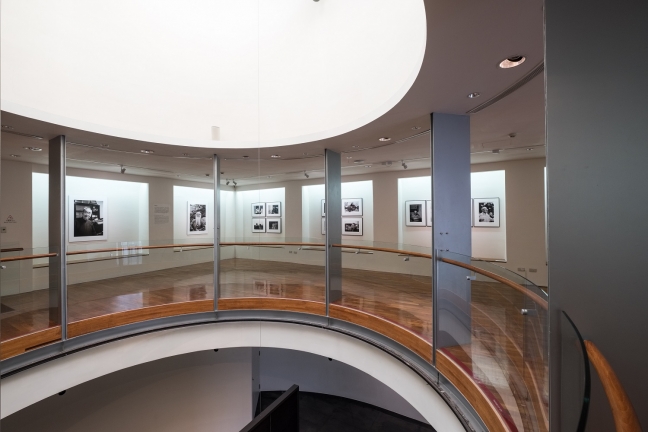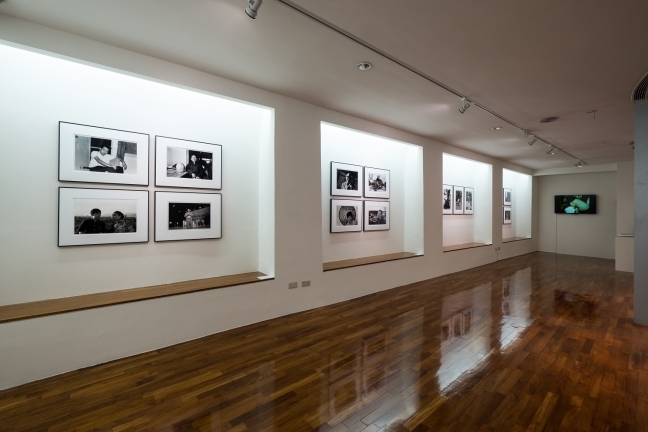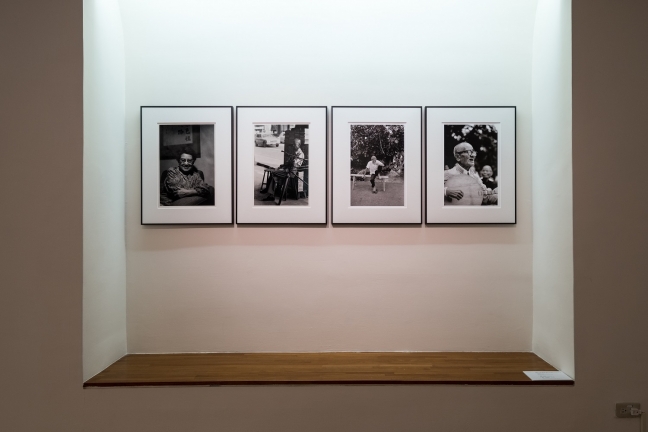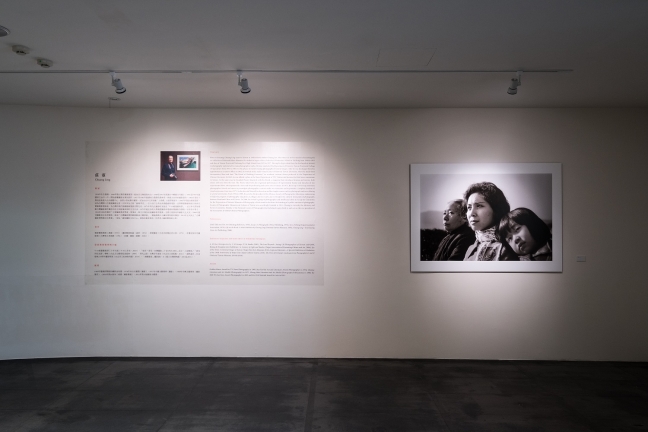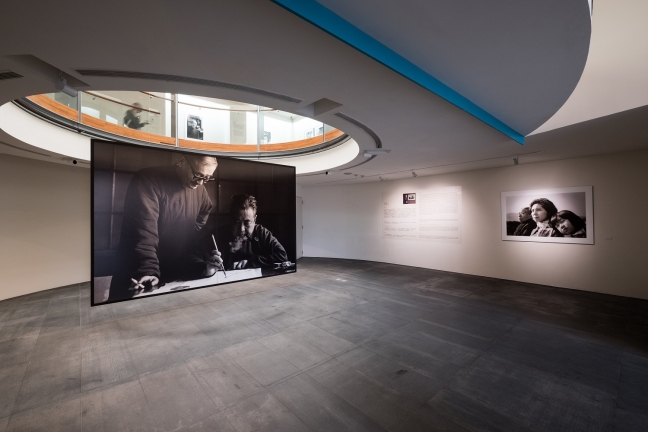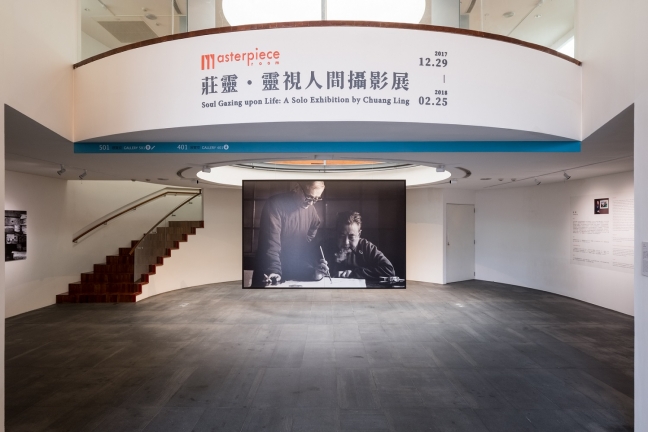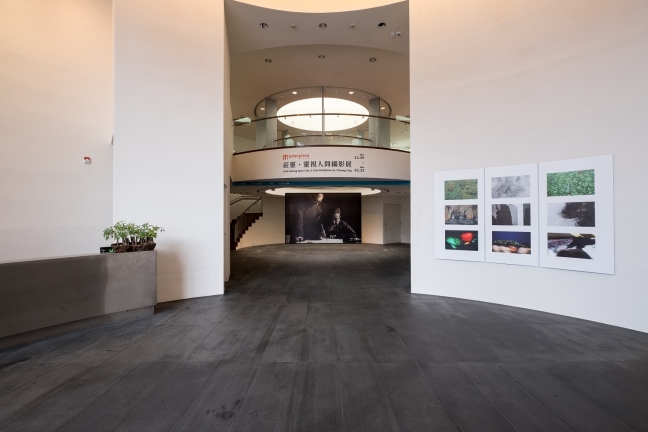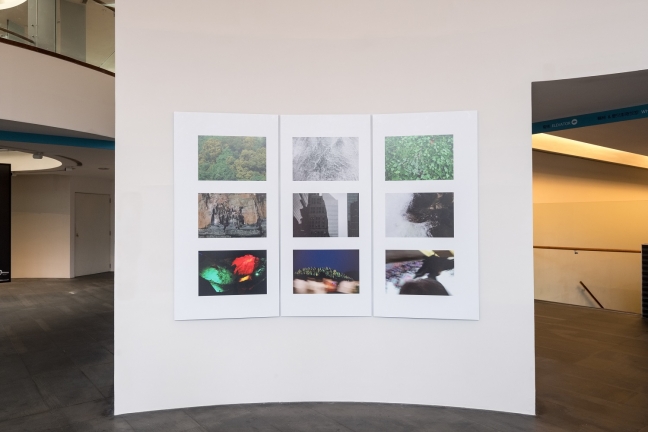Soul Gazing upon Life: A Solo Exhibition by Chuang Ling
2017.12.29~2018.02.25
09:00 - 17:00
Chuang Ling, now 79, has devoted all his life to photography. Driven by a strong passion for photography, Chuang started taking photographs when he was in the second grade of junior high school (1953) with a camera his father borrowed for him. From then on, photography has played a predominant role in his life for more than sixty years. During his teenage years, he was taught and inspired by his father, Chuang Yen, a life-long guardian of the cultural treasures of National Palace Museum. His elder brother Chuang Che, a famous painter, also enlightened him as to aesthetics. Chuang taught himself photography, and his perspectives on photography gradually took shape during the learning process. His expertise on forestry enabled him to look deep into nature. For more than thirty years, he worked as a news photographer at Taiwan Television Enterprise. The experience in this job greatly helped to broaden his horizon and enrich his artistic rendering. Chuang Ling’s photographic works highlight the
trueness” and
naturalness” of images. Taken in one shot, his photographic works combine visual and spiritual beauty and are endowed with the spirit of modern art. In addition to photographic creation, he writes articles and books on photography and devotes himself to educating young artists. He has taught photograph at National College of Arts (now National Taiwan University of Arts), Chinese Culture University, Ming Chuan University and Shih Hsin University. Apart from teaching, he concerns himself with the development of photography in Taiwan. He acted as the president of the Chinese Society of Photographic Education and Society of Photographic Museum and Culture of Taiwan. For years, he has striven to found and promote National Museum of Photography (now named National Center of Photography). Soul Gazing upon Life is a refined representation of his works after Towards Spiritual Perception at 70, a retrospective held in 2008. In this exhibition, change is made to the selection, number and arrangement of the displayed works. New works are added to show Chuang Ling’s artistic practice and characteristics. In addition to the four series, My Art Teachers and Friends, Approaching the Modern Era, Life Encounters, and Life on the Road, included in the exhibition are Life Continued and My Newborn Baby, two experimental films he made at the time when he founded Theater Quarterly with his friends in 1965. The viewers will have the chance to grasp Chuang Ling’s photographic works and get a glimpse of the development of photography in Taiwan through the films of his interviews. What is also presented is his lifelong effort and persistence in promoting photography in Taiwan. Supervisors: Organizer: Media Partners: Sponsors:
trueness” and
naturalness” of images. Taken in one shot, his photographic works combine visual and spiritual beauty and are endowed with the spirit of modern art. In addition to photographic creation, he writes articles and books on photography and devotes himself to educating young artists. He has taught photograph at National College of Arts (now National Taiwan University of Arts), Chinese Culture University, Ming Chuan University and Shih Hsin University. Apart from teaching, he concerns himself with the development of photography in Taiwan. He acted as the president of the Chinese Society of Photographic Education and Society of Photographic Museum and Culture of Taiwan. For years, he has striven to found and promote National Museum of Photography (now named National Center of Photography). Soul Gazing upon Life is a refined representation of his works after Towards Spiritual Perception at 70, a retrospective held in 2008. In this exhibition, change is made to the selection, number and arrangement of the displayed works. New works are added to show Chuang Ling’s artistic practice and characteristics. In addition to the four series, My Art Teachers and Friends, Approaching the Modern Era, Life Encounters, and Life on the Road, included in the exhibition are Life Continued and My Newborn Baby, two experimental films he made at the time when he founded Theater Quarterly with his friends in 1965. The viewers will have the chance to grasp Chuang Ling’s photographic works and get a glimpse of the development of photography in Taiwan through the films of his interviews. What is also presented is his lifelong effort and persistence in promoting photography in Taiwan. Supervisors: Organizer: Media Partners: Sponsors:
Chuang Ling, now 79, has devoted all his life to photography. Driven by a strong passion for photography, Chuang started taking photographs when he was in the second grade of junior high school (1953) with a camera his father borrowed for him. From then on, photography has played a predominant role in his life for more than sixty years. During his teenage years, he was taught and inspired by his father, Chuang Yen, a life-long guardian of the cultural treasures of National Palace Museum. His elder brother Chuang Che, a famous painter, also enlightened him as to aesthetics. Chuang taught himself photography, and his perspectives on photography gradually took shape during the learning process. His expertise on forestry enabled him to look deep into nature. For more than thirty years, he worked as a news photographer at Taiwan Television Enterprise. The experience in this job greatly helped to broaden his horizon and enrich his artistic rendering. Chuang Ling’s photographic works highlight the
trueness” and
naturalness” of images. Taken in one shot, his photographic works combine visual and spiritual beauty and are endowed with the spirit of modern art. In addition to photographic creation, he writes articles and books on photography and devotes himself to educating young artists. He has taught photograph at National College of Arts (now National Taiwan University of Arts), Chinese Culture University, Ming Chuan University and Shih Hsin University. Apart from teaching, he concerns himself with the development of photography in Taiwan. He acted as the president of the Chinese Society of Photographic Education and Society of Photographic Museum and Culture of Taiwan. For years, he has striven to found and promote National Museum of Photography (now named National Center of Photography). Soul Gazing upon Life is a refined representation of his works after Towards Spiritual Perception at 70, a retrospective held in 2008. In this exhibition, change is made to the selection, number and arrangement of the displayed works. New works are added to show Chuang Ling’s artistic practice and characteristics. In addition to the four series, My Art Teachers and Friends, Approaching the Modern Era, Life Encounters, and Life on the Road, included in the exhibition are Life Continued and My Newborn Baby, two experimental films he made at the time when he founded Theater Quarterly with his friends in 1965. The viewers will have the chance to grasp Chuang Ling’s photographic works and get a glimpse of the development of photography in Taiwan through the films of his interviews. What is also presented is his lifelong effort and persistence in promoting photography in Taiwan. Supervisors: Organizer: Media Partners: Sponsors:
trueness” and
naturalness” of images. Taken in one shot, his photographic works combine visual and spiritual beauty and are endowed with the spirit of modern art. In addition to photographic creation, he writes articles and books on photography and devotes himself to educating young artists. He has taught photograph at National College of Arts (now National Taiwan University of Arts), Chinese Culture University, Ming Chuan University and Shih Hsin University. Apart from teaching, he concerns himself with the development of photography in Taiwan. He acted as the president of the Chinese Society of Photographic Education and Society of Photographic Museum and Culture of Taiwan. For years, he has striven to found and promote National Museum of Photography (now named National Center of Photography). Soul Gazing upon Life is a refined representation of his works after Towards Spiritual Perception at 70, a retrospective held in 2008. In this exhibition, change is made to the selection, number and arrangement of the displayed works. New works are added to show Chuang Ling’s artistic practice and characteristics. In addition to the four series, My Art Teachers and Friends, Approaching the Modern Era, Life Encounters, and Life on the Road, included in the exhibition are Life Continued and My Newborn Baby, two experimental films he made at the time when he founded Theater Quarterly with his friends in 1965. The viewers will have the chance to grasp Chuang Ling’s photographic works and get a glimpse of the development of photography in Taiwan through the films of his interviews. What is also presented is his lifelong effort and persistence in promoting photography in Taiwan. Supervisors: Organizer: Media Partners: Sponsors:
Born in Guiyang, Chuang Ling came to Taiwan in 1948 with his father Chuang Yen, who then was on his mission of escorting the art collection of National Palace Museum. He studied at Sugar-refinery Subsidiary Elementary School in Taichung from 1949 to 1951 and then at Taiwan Provincial Taichung First High School from 1951 to 1957. During his high school days, he developed an interest in photography and started to create photographic works. He later studied at the Department of Forestry, Taiwan Provincial College of Agriculture from 1957 to 1961. In this phase, he took to taking photographs of natural images. After he was discharged from his appointment as a reserve officer in 1962, he worked at the Audio-visual Center of National Taiwan University, where he made short documentary films and shot “The Ritual of Wedding Ceremony,” an academic costume drama produced by the Department of Chinese Literature. In 1965, he was offered a place at the News Department of TTV Station and became the third news cameraman in Taiwan. In the same year, he founded Theater Quarterly with his friend, a magazine that introduced dramas and movies, both classic and new, from the west. The Theater Quarterly also organized performances of experimental theater and launches of two experimental films, which pioneered a new road for performing and screen arts in Taiwan. In 1971, he set up V-10 Groups with nine photographer friends and strove to promulgate photographic creation under no constraints and to promote a complete freedom of visual expression. Ever since 1971, he has devoted himself to education and has taught courses such as photograph and news filming at several universities. From 1994 to 1998, he acted as the president of the Chinese Society of Photographic Education, endeavoring to help the progress of photography education at colleges and in society and to broaden the cultural interaction of photography between Mainland China and Taiwan. In 2006, he invited a group of photographer and intellectual elites to set up the Committee for the Preparation of National Museum of Photography, which aimed to facilitate the founding of a public museum of photography. Society of Photographic Museum and Culture of Taiwan was accordingly founded in 2011. Chuang is currently the Advisory and Review Committee Member of the National Center of Photography that he helped to give birth to and acts as the vice president of the Association of Global Chinese Photographers. Publications Little Talks on Film Art (Morning Bell Press, 1970), Essays on Photography (Vista Publishing, 1976), News Filming (Taipei Journalist Association, 1979), Life on the Road: A Solo Exhibition by Chuang Ling (National Taiwan Museum, 1994), Chuang Ling‧Soul Gazing (Lion Art Publishing, 2008). Exhibition Organizer and Chief-editor of Exhibition Catalogues A 30-Year Retrospective by V-10 Groups (V-10 Studio, 2003), The Land Beyond•Seeing—20 Photographers of Taiwan 1928-2006, Beijing & Shanghai Joint Exhibition / A Century of Light and Shadow (Taipei Association of Promoting Culture and Art, 2006), Eye of the Times: Centennial Images of Taiwan (Taipei Fine Arts Museum, 2011), Captured Moments—A Special Exhibition in Celebration of the 130th Anniversary of Taipei City (Taipei Cultural Center, 2014), The View of Formosa’s Landscape from Photographers I and II (National Taiwan Museum, 2014 & 2016). Awards Golden Horse Award for TV News Photography in 1969, Sun Yat-sen Art and Literature Award (Photography) in 1976, Chinese Literature and Art Medal (Photography) in 1977, Chung-Hsin Literature and Art Medal (Photography Publications) in 1980, the 26th Wu San-Lien Award (Photography) in 2003 and the 15th National Award for Arts in 2011.
Born in Guiyang, Chuang Ling came to Taiwan in 1948 with his father Chuang Yen, who then was on his mission of escorting the art collection of National Palace Museum. He studied at Sugar-refinery Subsidiary Elementary School in Taichung from 1949 to 1951 and then at Taiwan Provincial Taichung First High School from 1951 to 1957. During his high school days, he developed an interest in photography and started to create photographic works. He later studied at the Department of Forestry, Taiwan Provincial College of Agriculture from 1957 to 1961. In this phase, he took to taking photographs of natural images. After he was discharged from his appointment as a reserve officer in 1962, he worked at the Audio-visual Center of National Taiwan University, where he made short documentary films and shot “The Ritual of Wedding Ceremony,” an academic costume drama produced by the Department of Chinese Literature. In 1965, he was offered a place at the News Department of TTV Station and became the third news cameraman in Taiwan. In the same year, he founded Theater Quarterly with his friend, a magazine that introduced dramas and movies, both classic and new, from the west. The Theater Quarterly also organized performances of experimental theater and launches of two experimental films, which pioneered a new road for performing and screen arts in Taiwan. In 1971, he set up V-10 Groups with nine photographer friends and strove to promulgate photographic creation under no constraints and to promote a complete freedom of visual expression. Ever since 1971, he has devoted himself to education and has taught courses such as photograph and news filming at several universities. From 1994 to 1998, he acted as the president of the Chinese Society of Photographic Education, endeavoring to help the progress of photography education at colleges and in society and to broaden the cultural interaction of photography between Mainland China and Taiwan. In 2006, he invited a group of photographer and intellectual elites to set up the Committee for the Preparation of National Museum of Photography, which aimed to facilitate the founding of a public museum of photography. Society of Photographic Museum and Culture of Taiwan was accordingly founded in 2011. Chuang is currently the Advisory and Review Committee Member of the National Center of Photography that he helped to give birth to and acts as the vice president of the Association of Global Chinese Photographers. Publications Little Talks on Film Art (Morning Bell Press, 1970), Essays on Photography (Vista Publishing, 1976), News Filming (Taipei Journalist Association, 1979), Life on the Road: A Solo Exhibition by Chuang Ling (National Taiwan Museum, 1994), Chuang Ling‧Soul Gazing (Lion Art Publishing, 2008). Exhibition Organizer and Chief-editor of Exhibition Catalogues A 30-Year Retrospective by V-10 Groups (V-10 Studio, 2003), The Land Beyond•Seeing—20 Photographers of Taiwan 1928-2006, Beijing & Shanghai Joint Exhibition / A Century of Light and Shadow (Taipei Association of Promoting Culture and Art, 2006), Eye of the Times: Centennial Images of Taiwan (Taipei Fine Arts Museum, 2011), Captured Moments—A Special Exhibition in Celebration of the 130th Anniversary of Taipei City (Taipei Cultural Center, 2014), The View of Formosa’s Landscape from Photographers I and II (National Taiwan Museum, 2014 & 2016). Awards Golden Horse Award for TV News Photography in 1969, Sun Yat-sen Art and Literature Award (Photography) in 1976, Chinese Literature and Art Medal (Photography) in 1977, Chung-Hsin Literature and Art Medal (Photography Publications) in 1980, the 26th Wu San-Lien Award (Photography) in 2003 and the 15th National Award for Arts in 2011.
Hsiao Chong-Ray Chuang Ling is an absolute epitome of the literati photographer in the postwar Taiwan. He has had a keen interest in photography ever since he got his first camera at the age of 14. He worked as a cameraman for 24 years, and his passion for photography continues to these days. His lifelong enthusiasm prompted him to promote the foundation of National Center of Photography. It may not be too much to assert that Chuang Ling’s life and his works in particular not only record the development of photography in postwar Taiwan but also witness the transition in Taiwan’s society. Growing up in a traditional Chinese family of intellectuals, Chuang Ling has a mild disposition and a spirit of gentleness. His works likewise reflect a state of mind that is true, natural, and real. They come of the deep reflection of an intellectual. In his works, we find no unusual composition, nor do we spot surprising images. Instead, we see in them diverse aspects of life that are captured undesignedly and casually. His photos, we may say, feature trueness and naturalness that are full of the spirit of the time as well as historicity. Since the days at the Joint Managerial Office of the National Palace Museum and the National Central Museum in Beigou, Taichung, Chuang Ling has taken photos of his family, the friends of his father, the neighbors and locals, his classmates as well as the landscape of local areas with a Minolta 35mm camera his father bought for him in Japan. The photos were brought forth by feelings arising out of life experiences. What is unique is that his family background offered him opportunities to capture precious images of the intellectuals and artists in a time of transition-- Chang Dai-Chien, Long Chin-San, Tai Ching-Nung, Chang Mu-Han, Wang Chuang-Wei, and many others. A large number of photos record his encounters with the friends of his father, Chuang Yen. In them we see the characteristics of early Chinese intellectuals, that is, gentleness, simplicity, integrity and self-discipline. As his life as a cameraman unfolded, Chuang Ling travelled a lot in Taiwan and abroad. In Life Encounters and Life on the Road, images of life in different cultures and areas are presented in rich and bright colors. Vividly captured in the photos are the statues of Greek gods, Venus in Paris, the Dongtai Fort in Penghu, the Forbidden City and the golden days in China, to name a few. It is obvious that Chuang Ling, an intellectual in essence, is very much attracted by artists contemporary with him, and he focuses his camera a lot on them during his leisure time. Images recorded in his photos include local singer Chen Da and amateur painter Hung Tung, Chou Meng-Tieh the recluse poet on the arcade, dancer Lin Hwai-Min, and literary men such as Chen Ying-Chen, Pai Hsien-Yung, and Hwang Chun-Ming. We can also see Yang Li-Hua, the super star of Taiwanese Opera, in her youth. Still other artist images that he collected with his camera are Liu Chi-Wei, Shiy De-Jinn, Kuo Ying-Sheng, Yang Ying-Feng, Chu Ko, Ju Ming, Lee Yih-Hong, his elder brother Chuang Che and many others. We may conclude that Chuang Ling’s My Art Teachers and Friends series serves well as a history of contemporary art in Taiwan. Moreover, he faithfully captures and presents with his camera the unique disposition and temperament of each artists. Greatly influenced by both his father and brother, Chuang Ling has a deep understanding of Chinese calligraphy and painting. In addition, he ventured upon modern art and gained a good grasp of it in his early years. His daring attempts did not get a favorable result from the mainstream Photographic Society of China, of which the jury gave his work a unanimous grade of zero points. Yet, years later, Chuang Ling was invited by the very Society that once rejected him to be its jury member. The nutrition with which modern art furnished him has been taken into and become essential part of his works. “Soul gazing” signifies seeing through the mind. It is a way of seeing that transcends physical eyes. In other words, it symbolizes what Chuang Ling sees through his “soul” and “prospective.” It echoes the title of his retrospective exhibition of the 70s. Nine years later, Chuang Ling, at the age of nearly 80, selects his important representative works and exhibits them under the title of Soul Gazing upon Life at Kuandu Museum of Fine Arts, National Taipei University of the Arts. It is a great occasion for young students to see Taiwan in a time of transition and to revisit its history through Chuang Ling’s eyes; so is it a good chance for them to admire the intellectuals of different generations. Chuang Ling’s “literati photography” is a record of the intellectuals, and even more so a representation of Chuang Ling’s very nature—a candid soul that lives at ease and at will without any affectations and that sees into the real through the mind.
Hsiao Chong-Ray Chuang Ling is an absolute epitome of the literati photographer in the postwar Taiwan. He has had a keen interest in photography ever since he got his first camera at the age of 14. He worked as a cameraman for 24 years, and his passion for photography continues to these days. His lifelong enthusiasm prompted him to promote the foundation of National Center of Photography. It may not be too much to assert that Chuang Ling’s life and his works in particular not only record the development of photography in postwar Taiwan but also witness the transition in Taiwan’s society. Growing up in a traditional Chinese family of intellectuals, Chuang Ling has a mild disposition and a spirit of gentleness. His works likewise reflect a state of mind that is true, natural, and real. They come of the deep reflection of an intellectual. In his works, we find no unusual composition, nor do we spot surprising images. Instead, we see in them diverse aspects of life that are captured undesignedly and casually. His photos, we may say, feature trueness and naturalness that are full of the spirit of the time as well as historicity. Since the days at the Joint Managerial Office of the National Palace Museum and the National Central Museum in Beigou, Taichung, Chuang Ling has taken photos of his family, the friends of his father, the neighbors and locals, his classmates as well as the landscape of local areas with a Minolta 35mm camera his father bought for him in Japan. The photos were brought forth by feelings arising out of life experiences. What is unique is that his family background offered him opportunities to capture precious images of the intellectuals and artists in a time of transition-- Chang Dai-Chien, Long Chin-San, Tai Ching-Nung, Chang Mu-Han, Wang Chuang-Wei, and many others. A large number of photos record his encounters with the friends of his father, Chuang Yen. In them we see the characteristics of early Chinese intellectuals, that is, gentleness, simplicity, integrity and self-discipline. As his life as a cameraman unfolded, Chuang Ling travelled a lot in Taiwan and abroad. In Life Encounters and Life on the Road, images of life in different cultures and areas are presented in rich and bright colors. Vividly captured in the photos are the statues of Greek gods, Venus in Paris, the Dongtai Fort in Penghu, the Forbidden City and the golden days in China, to name a few. It is obvious that Chuang Ling, an intellectual in essence, is very much attracted by artists contemporary with him, and he focuses his camera a lot on them during his leisure time. Images recorded in his photos include local singer Chen Da and amateur painter Hung Tung, Chou Meng-Tieh the recluse poet on the arcade, dancer Lin Hwai-Min, and literary men such as Chen Ying-Chen, Pai Hsien-Yung, and Hwang Chun-Ming. We can also see Yang Li-Hua, the super star of Taiwanese Opera, in her youth. Still other artist images that he collected with his camera are Liu Chi-Wei, Shiy De-Jinn, Kuo Ying-Sheng, Yang Ying-Feng, Chu Ko, Ju Ming, Lee Yih-Hong, his elder brother Chuang Che and many others. We may conclude that Chuang Ling’s My Art Teachers and Friends series serves well as a history of contemporary art in Taiwan. Moreover, he faithfully captures and presents with his camera the unique disposition and temperament of each artists. Greatly influenced by both his father and brother, Chuang Ling has a deep understanding of Chinese calligraphy and painting. In addition, he ventured upon modern art and gained a good grasp of it in his early years. His daring attempts did not get a favorable result from the mainstream Photographic Society of China, of which the jury gave his work a unanimous grade of zero points. Yet, years later, Chuang Ling was invited by the very Society that once rejected him to be its jury member. The nutrition with which modern art furnished him has been taken into and become essential part of his works. “Soul gazing” signifies seeing through the mind. It is a way of seeing that transcends physical eyes. In other words, it symbolizes what Chuang Ling sees through his “soul” and “prospective.” It echoes the title of his retrospective exhibition of the 70s. Nine years later, Chuang Ling, at the age of nearly 80, selects his important representative works and exhibits them under the title of Soul Gazing upon Life at Kuandu Museum of Fine Arts, National Taipei University of the Arts. It is a great occasion for young students to see Taiwan in a time of transition and to revisit its history through Chuang Ling’s eyes; so is it a good chance for them to admire the intellectuals of different generations. Chuang Ling’s “literati photography” is a record of the intellectuals, and even more so a representation of Chuang Ling’s very nature—a candid soul that lives at ease and at will without any affectations and that sees into the real through the mind.
Chang Chao-Tang When talking about Chuang Ling’s photography, people in the artistic circles tend to use words such as “natural,” “plain,” “amicable,” and “gentle,” or they may employ words like “encounters,” “reflection,” “soul gazing,” and “feelings,” the terms that Chuang Ling himself uses to talk about his own works. These terms are not only the gospel according to which he takes photos and to which he lives, but also the melodic resonance and shimmering light given forth by his character and disposition that are faithfully reflected in his works. Chuang Ling’s father, Chuang Yen, is a follower of Confucius who specializes in Chinese calligraphy and historical monuments; his oldest brother, Chuang Shen, is a scholar of Chinese art history; his second oldest brother, Chuang Yin, is a literary man; and his older brother, Chuang Che, is a modern artist. Growing up in a family of artists and literati, it is not surprising that Chuang chose photography as his career after graduating from the Department of Forestry. The Chuangs, which is usually referred to as “a family of intellectuals” and “a household of four brilliant people,” has been much admired in the artistic and literary circles in Taipei. It was half a century ago when I first met Chuang Ling. I was studying at College of Engineering, National Taiwan University in the early 60s. Chuang Ling worked as a technical specialist at the Audio-visual Center of College of Agriculture, where he was in charge of photographing as well as running and managing the darkroom. I was fascinated by photography at that time and I would visit him whenever I had questions about photographing. Chuang Ling was later offered a position at the News Department of TTV Station. At that time, he and his friends founded Theater Quarterly. I attended the activities they held a lot. I started to work at CTV News in the late 60s. During the time, I met him frequently at work. I was very much encouraged and inspired by his cordiality and amicability. In 1971, we took part in the foundation of V-10 Group, which aimed “to present modern society and to reveal the inner self with new instincts and from new aspects.” For thirty years, V-10 Group has held many exhibitions and talks, which imbued the dull photographic circles with vitality and energy. Chuang Ling is not only the founder but also the soul of V-10 Group. Without him, this group would never achieve so much. Chuang Ling’s photographs can be generally classified into eight categories, which include realistic landscapes, portraits, news events, picturesque images and personal reflections. His early works like Memories of Beigou as well as Father.Dongtian Mountain Hall, and My family are collections of sentimental memories of the folk, the land, the country side, and nature. All the images are faithfully captured by Chuang Ling, who sees life in a simple, sincere and modest way. In the series of his family, his deep love for the family is expressed in a reserved but natural way through a delicate manipulation of light and shadow, composition and camera angles. He once said, “My family is one of the best topics for me to practice photography.” Through the modest remark that he made about himself, we clearly see that the photographs he took for practice have turned into his accomplishments. In Chuang Ling’s early works, we find profound nostalgia, peace, and aspiration, that is, the Confucian spirit that he learns from his father. It is incredible that his ability of “soul gazing” matured and anticipated others half a century ago. These works are indeed outstanding examples of portraits and related subjects in the development of photography in Taiwan. Chuang Ling is easygoing and enjoys making friends with people from all walks of life. He worked as a cameraman for 24 years, which offered him the opportunities to meet a lot of celebrities and literati. My Art Techers and Friends is a collection of celebrity photos. The images captured are as natural and real as those of the souvenir pictures. Chuang Ling likes taking photos impromptu and undesignedly. He does not employ artificial light, nor does he use in his photos any decorations or contrived composition. The photos were taken in his encounters with the artists and literary men. He pressed the shutter button casually, attracting the least attention of the subjects. We see in them Chou Meng-Tieh taking an afternoon nap on the arcade, Hung Tung smoking with his legs crossed, Chen Da singing and playing a musical instrument, Yang Li-Hua eating box lunch. . .. The photos capture many precious images and unceremonious gestures of these legendary people. They are especially valuable as they record the fascinating images from the past. In the middle and later phases of his art career, Chuang Ling turned his focus from people, events and news to lines, styling, and natural features. In Life on the Road, Life Encounters, and Understanding Nature, he tried to present deep and reserved feelings through an instinctive, direct, and spontaneous way. He said, “Let photography presents naturally all the visible things in life; and let all visible things return to the vast and immense nature. This is what I have been seeking and longing for.” Chuang Ling’s family education and his character shape his attitudes towards life and art creation. He does not blindly follow what is in fashion, nor does he change his stance to go with the current popular sentiment. He walks his way naturally, quietly and steadily. In addition to artistic creation, he concerns himself with the development and promotion of photography. His devotion has won him unanimous applause and admiration from the photographic circles. Chuang Ling is like a bridge which spans the gap between the traditional and the modern. This bridge links three major aspects of his life—his artworks, his effort to educate the youth, and his continual involvement in the promotion of photography. Back and forth he walks on the bridge, departing from the traditional to the modern, and returning to the traditional again. By the to-ing and fro-ing between the old and the new, he hopes to make himself a natural and balanced whole. At nearly 80, I believe Chuang Ling has been fully assured of this aspiration.
Chang Chao-Tang When talking about Chuang Ling’s photography, people in the artistic circles tend to use words such as “natural,” “plain,” “amicable,” and “gentle,” or they may employ words like “encounters,” “reflection,” “soul gazing,” and “feelings,” the terms that Chuang Ling himself uses to talk about his own works. These terms are not only the gospel according to which he takes photos and to which he lives, but also the melodic resonance and shimmering light given forth by his character and disposition that are faithfully reflected in his works. Chuang Ling’s father, Chuang Yen, is a follower of Confucius who specializes in Chinese calligraphy and historical monuments; his oldest brother, Chuang Shen, is a scholar of Chinese art history; his second oldest brother, Chuang Yin, is a literary man; and his older brother, Chuang Che, is a modern artist. Growing up in a family of artists and literati, it is not surprising that Chuang chose photography as his career after graduating from the Department of Forestry. The Chuangs, which is usually referred to as “a family of intellectuals” and “a household of four brilliant people,” has been much admired in the artistic and literary circles in Taipei. It was half a century ago when I first met Chuang Ling. I was studying at College of Engineering, National Taiwan University in the early 60s. Chuang Ling worked as a technical specialist at the Audio-visual Center of College of Agriculture, where he was in charge of photographing as well as running and managing the darkroom. I was fascinated by photography at that time and I would visit him whenever I had questions about photographing. Chuang Ling was later offered a position at the News Department of TTV Station. At that time, he and his friends founded Theater Quarterly. I attended the activities they held a lot. I started to work at CTV News in the late 60s. During the time, I met him frequently at work. I was very much encouraged and inspired by his cordiality and amicability. In 1971, we took part in the foundation of V-10 Group, which aimed “to present modern society and to reveal the inner self with new instincts and from new aspects.” For thirty years, V-10 Group has held many exhibitions and talks, which imbued the dull photographic circles with vitality and energy. Chuang Ling is not only the founder but also the soul of V-10 Group. Without him, this group would never achieve so much. Chuang Ling’s photographs can be generally classified into eight categories, which include realistic landscapes, portraits, news events, picturesque images and personal reflections. His early works like Memories of Beigou as well as Father.Dongtian Mountain Hall, and My family are collections of sentimental memories of the folk, the land, the country side, and nature. All the images are faithfully captured by Chuang Ling, who sees life in a simple, sincere and modest way. In the series of his family, his deep love for the family is expressed in a reserved but natural way through a delicate manipulation of light and shadow, composition and camera angles. He once said, “My family is one of the best topics for me to practice photography.” Through the modest remark that he made about himself, we clearly see that the photographs he took for practice have turned into his accomplishments. In Chuang Ling’s early works, we find profound nostalgia, peace, and aspiration, that is, the Confucian spirit that he learns from his father. It is incredible that his ability of “soul gazing” matured and anticipated others half a century ago. These works are indeed outstanding examples of portraits and related subjects in the development of photography in Taiwan. Chuang Ling is easygoing and enjoys making friends with people from all walks of life. He worked as a cameraman for 24 years, which offered him the opportunities to meet a lot of celebrities and literati. My Art Techers and Friends is a collection of celebrity photos. The images captured are as natural and real as those of the souvenir pictures. Chuang Ling likes taking photos impromptu and undesignedly. He does not employ artificial light, nor does he use in his photos any decorations or contrived composition. The photos were taken in his encounters with the artists and literary men. He pressed the shutter button casually, attracting the least attention of the subjects. We see in them Chou Meng-Tieh taking an afternoon nap on the arcade, Hung Tung smoking with his legs crossed, Chen Da singing and playing a musical instrument, Yang Li-Hua eating box lunch. . .. The photos capture many precious images and unceremonious gestures of these legendary people. They are especially valuable as they record the fascinating images from the past. In the middle and later phases of his art career, Chuang Ling turned his focus from people, events and news to lines, styling, and natural features. In Life on the Road, Life Encounters, and Understanding Nature, he tried to present deep and reserved feelings through an instinctive, direct, and spontaneous way. He said, “Let photography presents naturally all the visible things in life; and let all visible things return to the vast and immense nature. This is what I have been seeking and longing for.” Chuang Ling’s family education and his character shape his attitudes towards life and art creation. He does not blindly follow what is in fashion, nor does he change his stance to go with the current popular sentiment. He walks his way naturally, quietly and steadily. In addition to artistic creation, he concerns himself with the development and promotion of photography. His devotion has won him unanimous applause and admiration from the photographic circles. Chuang Ling is like a bridge which spans the gap between the traditional and the modern. This bridge links three major aspects of his life—his artworks, his effort to educate the youth, and his continual involvement in the promotion of photography. Back and forth he walks on the bridge, departing from the traditional to the modern, and returning to the traditional again. By the to-ing and fro-ing between the old and the new, he hopes to make himself a natural and balanced whole. At nearly 80, I believe Chuang Ling has been fully assured of this aspiration.

